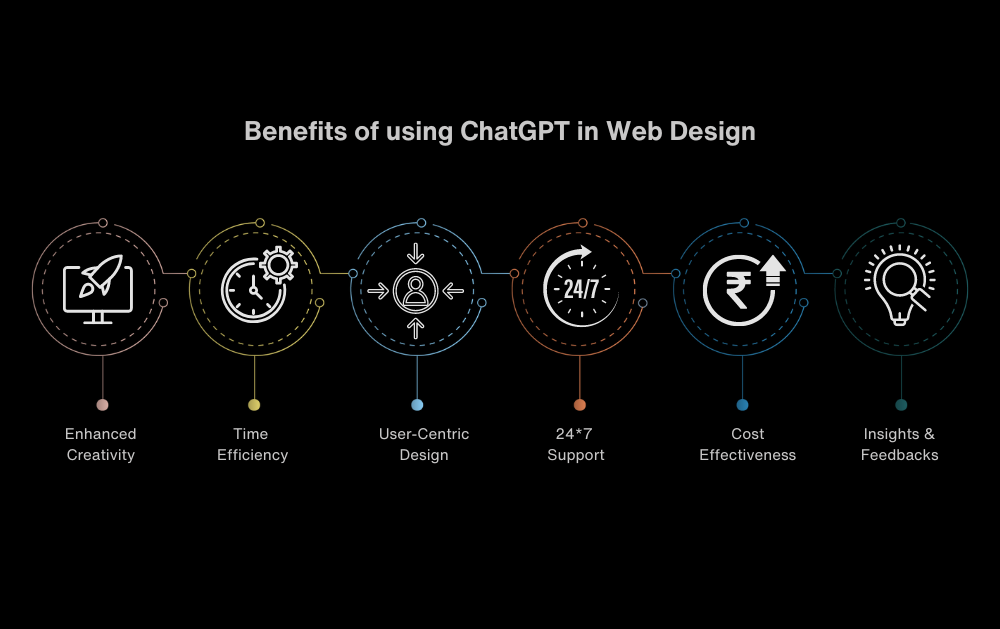ChatGPT is quickly becoming an invaluable tool for web designers and developers, offering a wide range of capabilities that can help improve efficiency and productivity. From automating repetitive tasks to providing instant feedback on code, ChatGPT is transforming the way web designers and developers approach their work.
Creating websites that capture and retain users is more important than ever, by incorporating ChatGPT into their web design, businesses can open up a new level of connection with their online audience, building relationships and driving engagement.
In this article, we will look at how ChatGPT improves user engagement and opens up a new level of connection between businesses and their online visitors.
ChatGPT in Web Design
ChatGPT is an AI language model that understands and replies in conversation like humans. Using artificial intelligence and natural language processing (NLP), it reads user inquiries, offers relevant responses, and engages in meaningful communication.
Deep learning, notably the Transformer model architecture, powers ChatGPT. It recognises text patterns by training with massive volumes of data, allowing it to forecast the next most likely words or phrases based on attachments and context. Designers can construct conversational experiences that boost user interaction with websites by understanding the ChatGPT features.
Benefits of using ChatGPT in the Web Design Process
While ChatGPT cannot directly assist in website design, including it into the process can provide essential support and improve workflow for both UX (user experience) and UI (user interface) designers. Using ChatGPT in the web design process helps the designer to boosts creativity by providing new ideas and inspiration. It saves time during brainstorming, and enables user-centric design with personalised recommendations.
ChatGPT also enables continuous learning and improvement through user feedback analysis, provides round-the-clock support for users. These advantages lead to the creation of interesting and personalised web designs that increase user engagement and satisfaction.

Enhancing User Engagement & Satisfaction with ChatGPT
ChatGPT is an AI-powered chatbot system that has the potential to revolutionise business customer satisfaction. ChatGPT can deliver various benefits to businesses by automating typical customer support operations and offering natural language-based interactions. It can play a significant role in enhancing user engagement in several ways:
1. Personalized Interactions and experiences
Websites can utilize ChatGPT to establish personalised interactions with their visitors. ChatGPT can deliver personalised recommendations, product recommendations, and material that suits the user’s interests by analysing user inputs, preferences, and browsing behaviour. This level of personalisation results in a more interesting and relevant user experience, which increases conversion and customer satisfaction.
2. Help and assistance in real time
ChatGPT can act as a virtual assistant, providing users with rapid aid and guidance. It can provide answers to frequently asked issues, troubleshooting assistance, and step-by-step instructions. This real-time assistance improves the user experience by minimizing frustration, shortening wait times, and ensuring that customers get the service they need quickly and efficiently.
3. The content distribution that is interactive and dynamic
ChatGPT-enabled websites can deliver interactive and dynamic content experiences. Chatbots powered by ChatGPT can converse with users, directing them through content, quizzes, or interactive elements. This method boosts user engagement by offering a more immersive and engaging experience, making the website more memorable and enjoyable for visitors.
4. Natural language understanding and communication
ChatGPT’s advanced natural language processing capabilities enable it to understand and respond to users in a more human-like manner. It can interpret complex queries, understand context, and generate meaningful responses. This level of communication enhances user satisfaction by providing more accurate and relevant information, leading to a higher level of trust and confidence in the website.
5. Multilingual Support
With its language processing capabilities, ChatGPT can provide support in multiple languages, catering to a global audience. This enables businesses to engage with users from different regions and cultures, breaking down language barriers and increasing user satisfaction by offering support in their preferred language.
6. Feedback and User Insights:
Obtaining user input and insights is critical for continuous web design improvement. ChatGPT can help with this process by gathering user feedback, analysing user interactions, and extracting useful information. Websites can receive real-time input, identify pain points, and make data-driven design decisions by integrating feedback systems like chatbots. It can also aid businesses with sentiment analysis, determining user satisfaction levels, and optimising their websites depending on user preferences.
Best Practises for Using ChatGPT in Web Design
- Defining explicit goals and use cases: Clearly identify the goals and use cases for incorporating ChatGPT into web design. Determine the precise areas where ChatGPT may bring value, such as personalised suggestions, support, or interactive features. Having a clear vision aids in efficiently deploying ChatGPT to improve user engagement and satisfaction.
- Designing intuitive and user-friendly interfaces: Ensure that the ChatGPT interface is intuitive and user-friendly. Design it to mix in with the main website design and navigation. Use clear instructions, prompts, and visual cues to show users how to interact with ChatGPT efficiently. A well-designed interface improves the user experience and encourages users to participate with ChatGPT more confidently.
- ChatGPT training and fine-tuning for best outcomes: Train ChatGPT on pertinent data to ensure that its responses are consistent with the website’s aims and user expectations. Adjust the model so that it provides accurate and relevant information. Monitor user interactions and feedback on an ongoing basis to find areas for improvement and to fine-tune the ChatGPT’s effectiveness over time.
- User feedback monitoring and analysis for continual improvement: Monitor user feedback, comments, and suggestions about ChatGPT on a regular basis. Analyse the data to discover common pain points, areas of misunderstanding, or improvement recommendations. To improve the user experience and maximise user satisfaction, actively address user problems, iterate on the design, and incorporate user feedback.
By adhering to these best practises, websites can effectively employ ChatGPT to increase user engagement and satisfaction, resulting in higher conversion rates, client loyalty, and overall success in the digital realm.
Conclusion
ChatGPT, powered by AI, transforms online design by delivering exceptional user experiences and increasing customer satisfaction. Its contextual modelling, preference learning, personalization, natural language comprehension, and adaptive UX design capabilities enable enterprises to deliver customised content and experiences, increasing user engagement dramatically.
Looking ahead, the future of ChatGPT in web design promises to be interesting. Natural language processing will advance, enabling for more human-sounding discussions. Intuitive interactions will be provided by integration with voice assistants and virtual reality, while personalised AI companions and virtual customer support agents will deepen connections. Adopting these innovations will result in excellent web experiences, driving long-term engagement and success.
About Author:

Khurshid Alam is the founder and director of Pixel Street. A top Web Design Company In Kolkata. He has over 8 years of experience in the industry and has worked with some of the world’s leading brands including ITC, The Hindu Group, Glocal Healthcare, etc.

